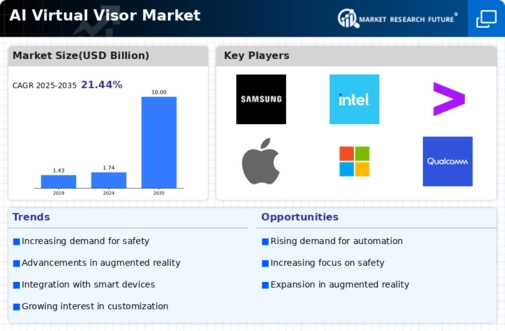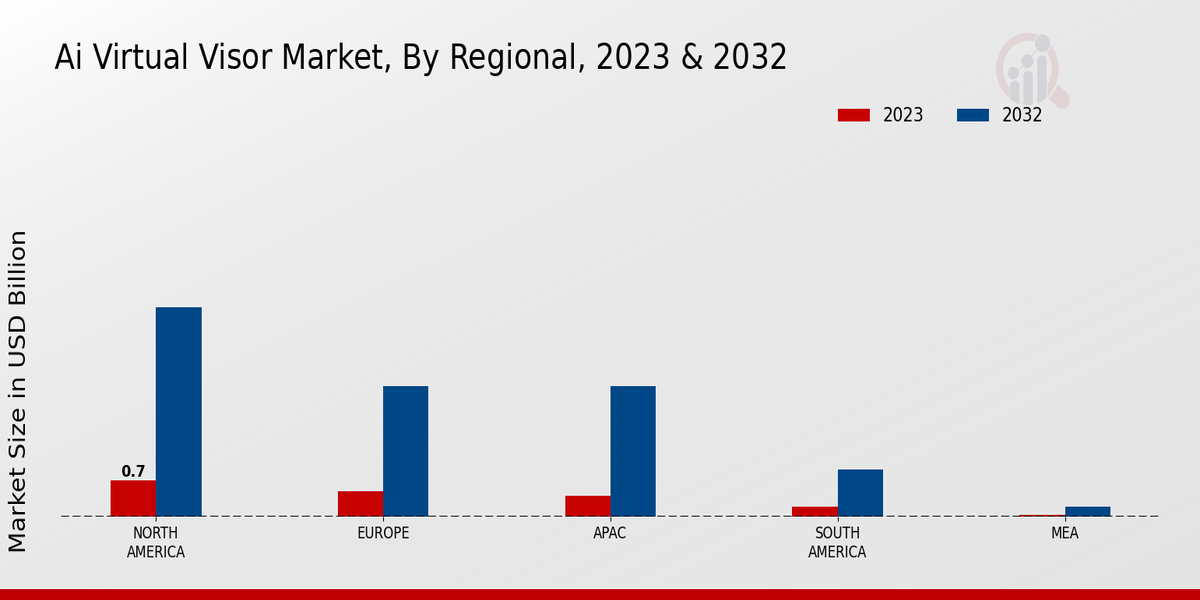Expansion of Smart Cities
The expansion of smart cities is creating new opportunities for the Global AI Virtual Visor Market Industry. As urban areas evolve into smart environments, the integration of AI technologies becomes crucial for efficient transportation and communication. AI virtual visors can play a significant role in smart city initiatives by providing real-time data to users, enhancing navigation, and improving overall urban mobility. This trend aligns with global efforts to create sustainable and technologically advanced urban spaces, potentially increasing the market's value significantly in the coming years.
Market Growth Projections
The Global AI Virtual Visor Market Industry is projected to witness substantial growth over the next decade. With a market valuation of 1.74 USD Billion in 2024, it is anticipated to reach 10 USD Billion by 2035. This growth trajectory suggests a compound annual growth rate of 17.23% from 2025 to 2035, indicating strong demand and investment in AI virtual visor technologies. The increasing integration of these systems across various sectors, including automotive and smart cities, reflects a broader trend towards enhanced user experiences and safety features.
Technological Advancements
The Global AI Virtual Visor Market Industry experiences rapid growth due to continuous technological advancements. Innovations in artificial intelligence and machine learning enhance the functionality of virtual visors, making them more efficient and user-friendly. For instance, the integration of augmented reality features allows users to interact with their environment seamlessly. As of 2024, the market is valued at approximately 1.74 USD Billion, indicating a strong demand for these technologies. This trend is expected to continue, as advancements in sensor technology and data processing capabilities further improve the performance of AI virtual visors.
Rising Awareness of Safety Features
The heightened awareness of safety features among consumers is propelling the Global AI Virtual Visor Market Industry forward. As individuals become more conscious of road safety and accident prevention, the demand for technologies that enhance situational awareness grows. AI virtual visors provide critical information such as blind spot detection and collision warnings, which are essential for safe driving. This increasing focus on safety is likely to drive market growth, as manufacturers prioritize the development of advanced safety features in their products, aligning with consumer expectations and regulatory standards.
Increasing Adoption in Automotive Sector
The automotive sector plays a pivotal role in driving the Global AI Virtual Visor Market Industry. With the rise of autonomous vehicles, manufacturers are increasingly incorporating AI virtual visors to enhance driver safety and experience. These visors provide real-time information, navigation assistance, and hazard alerts, thereby improving overall vehicle functionality. The projected market growth from 1.74 USD Billion in 2024 to an estimated 10 USD Billion by 2035 underscores the automotive industry's commitment to integrating advanced technologies. This adoption is likely to accelerate as regulatory frameworks evolve to support innovative safety features.
Growing Demand for Enhanced User Experience
Consumer expectations for enhanced user experiences are significantly influencing the Global AI Virtual Visor Market Industry. Users seek personalized and interactive interfaces that improve usability and engagement. AI virtual visors cater to this demand by offering tailored content and adaptive functionalities based on user preferences. As the market evolves, companies are focusing on developing intuitive designs that integrate seamlessly into daily activities. This trend is expected to contribute to a compound annual growth rate of 17.23% from 2025 to 2035, reflecting the increasing importance of user-centric technology in various applications.

























